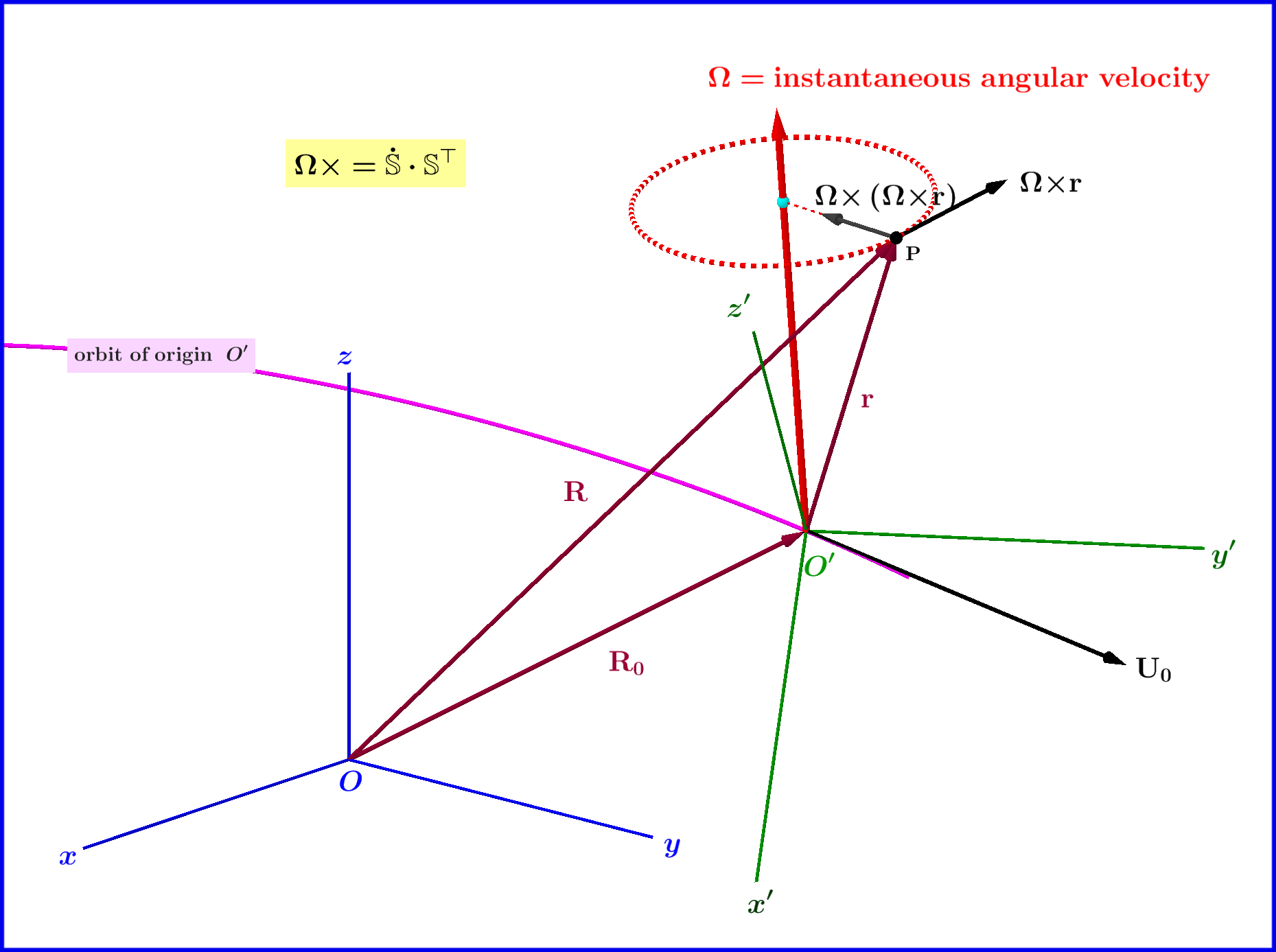Let two orthonormal systems $Oxyz$, $O'x'y'z'$ with a general motion (translational plus rotational) between each other and a point particle $\rm P$, see Figure.
Symbol Conventions :
1.The vectors for position $\mathbf{R}$, velocity $\mathbf{U}$ and acceleration $\mathbf{A}$ of a particle with respect to $Oxyz$ expressed by coordinates of this same system are symbolized with bold upper-case letters.
2.The vectors for position $\mathbf{r}^{\prime}$, velocity $\mathbf{u}^{\prime}$ and acceleration $\mathbf{a}^{\prime}$ of a particle with respect to $O'x'y'z'$ expressed by coordinates of this same system are symbolized with bold accented lower-case letters.
3.The vectors for position $\mathbf{R}^{\prime}$, velocity $\mathbf{U}^{\prime}$ and acceleration $\mathbf{A}^{\prime}$ of a particle with respect to $Oxyz$ expressed by coordinates of the other system $O'x'y'z'$ are symbolized with bold accented upper-case letters and finally
4.The vectors for position $\mathbf{r}$, velocity $\mathbf{u}$ and acceleration $\mathbf{a}$ of a particle with respect to $O'x'y'z'$ expressed by coordinates of the other system $Oxyz$ are symbolized with bold lower-case letters.
Since the two systems are orthonormal any accented vector (upper-case $\mathbf{V}^{\prime}$ or lower-case $\mathbf{v}^{\prime}$) that is expressed with $O'x'y'z'$-coordinates may be expressed with $Oxyz$-coordinates via an orthonormal transformation $\;\Bbb{S}(t)\;$
\begin{equation}
\mathbf{V}=\Bbb{S}\;\mathbf{V}^{\prime} \quad \text{or} \quad \mathbf{v}=\Bbb{S}\;\mathbf{v}^{\prime}
\tag{01}
\end{equation}
with properties
\begin{equation}
\Bbb{S}\Bbb{S}^{\top}=\Bbb{I}= \Bbb{S}^{\top}\Bbb{S},\quad \det\left(\Bbb{S}\right)=+1
\tag{02}
\end{equation}
This transformation represents also the rotation which when applied to system $Oxyz$ brings it in coincidence with $O'x'y'z'$.

PART 1 : Velocities
Let a moving particle be at point $\rm P$ at time $t$. Its position vector relative to $\;Oxyz\;$ is $\;\mathbf{R}(t)\;$ and
\begin{equation}
\mathbf{R}\left(t\right)=\mathbf{R}_{0}\left(t\right)+\mathbf{r}\left(t\right)
\tag{03}
\end{equation}
where $\mathbf{r}(t)$ is its position vector relative to $\;O'x'y'z'\;$ expressed with
$\;Oxyz$-coordinates. Also $\mathbf{R}_{0}\left(t\right)$ is the position vector of the origin $O'$ relative to $\;Oxyz\;$ expressed with $\;Oxyz$-coordinates. So
\begin{equation}
\mathbf{R}(t)=\mathbf{R}_{0}(t)+\mathbf{r}(t)=\mathbf{R}_{0}(t)+\Bbb{S}(t)\:\mathbf{r}^{\prime}(t)
\tag{04}
\end{equation}
It must be noticed that the rotation operator $\;\Bbb{S}(t)\;$ depends generally on time as all other quantities $\mathbf{R},\mathbf{U},\mathbf{A},\mathbf{r},\mathbf{u},\mathbf{a}, \ldots$
From now on in all equations we'll drop the explicit dependence on time $\;t\;$ and so above equation (04) takes the simple form
\begin{equation}
\mathbf{R}=\mathbf{R}_{0}+\mathbf{r}=\mathbf{R}_{0}+\Bbb{S}\:\mathbf{r}^{\prime}
\tag{05}
\end{equation}
Also we'll use one, two or any number of dots to express the time derivatives of first, second or of any order respectively for any quantity (scalar, vector, matrix etc).
Taking time derivatives of equation (05) we have
\begin{equation}
\overset{_{^{\bullet}}}{\mathbf{R}}=\overset{_{^{\bullet}}}{\mathbf{R}}_{0}+\overset{_{^{\bullet}}}{\Bbb{S}}\mathbf{r}^{\prime}+\Bbb{S}\overset{_{_{\bullet}}}{\mathbf{r}^{\prime}}
\tag{06}
\end{equation}
written as
\begin{equation}
\mathbf{U}=\mathbf{U_{0}}+\overset{_{^{\bullet}}}{\Bbb{S}}\:\Bbb{S}^{\top}\:\mathbf{r}+\Bbb{S}\:\mathbf{u}^{\prime}
\tag{07}
\end{equation}
or
\begin{equation}
\mathbf{U}=\mathbf{U_{0}}+\overset{_{^{\bullet}}}{\Bbb{S}}\:\Bbb{S}^{\top}\:\mathbf{r}+\mathbf{u}
\tag{08}
\end{equation}
where by definition
\begin{eqnarray}
\mathbf{U}\equiv & \overset{_{^{\bullet}}}{\mathbf{R}}\; &=\;\text{velocity of particle relative to $Oxyz$ at time $t$}
\nonumber\\
\mathbf{U_{0}}\equiv & \overset{_{^{\bullet}}}{\mathbf{R}}_{0}\; &=\;\text{velocity of origin $O'$ relative to $Oxyz$ at time $t$}
\nonumber\\
\mathbf{u}^{\prime} \equiv & \overset{_{_{\bullet}}}{\mathbf{r}^{\prime}}\; &=\;\text{velocity of particle relative to $O'x'y'z'$ at time $t$}
\nonumber\\
\mathbf{u}\equiv & \Bbb{S}\:\mathbf{u}^{\prime}\; & =\;\text{as $\mathbf{u}^{\prime}$ but expressed in $Oxyz$-coordinates}
\nonumber
\end{eqnarray}
Now, let discuss the term $\overset{_{^{\bullet}}}{\Bbb{S}}\:\Bbb{S}^{\top}$ in equation (08).
Differentiating the first equation in (02) we have
\begin{equation}
\Bbb{S}\Bbb{S}^{\top}=\Bbb{I}\ \Rightarrow\ \overset{_{^{\bullet}}}{\Bbb{S}}\:\Bbb{S}^{\top}+\Bbb{S}\:\overset{_{^{\bullet}}}{\left(\Bbb{S}^{\top}\right)}=\Bbb{O}
\tag{09}
\end{equation}
but
\begin{equation}
\overset{_{^{\bullet}}}{\left(\Bbb{S}^{\top}\right)}\:=\:\left(\overset{_{^{\bullet}}}{\Bbb{S}}\right)^{\top}
\tag{10}
\end{equation}
so
\begin{equation}
\overset{_{^{\bullet}}}{\Bbb{S}}\:\Bbb{S}^{\top}\:=\:-\:\left(\overset{_{^{\bullet}}}{\Bbb{S}}\:\Bbb{S}^{\top}\right)^{\top}
\tag{11}
\end{equation}
The following defined matrix
\begin{equation}
\Bbb{W}\:\equiv\:\overset{_{^{\bullet}}}{\Bbb{S}}\:\Bbb{S}^{\top}\:=\:\text{antisymmetric matrix}
\tag{12}
\end{equation}
can be represented by the vector $\boldsymbol{\Omega}$
\begin{equation}
\Bbb{W}\:\equiv\:\overset{_{^{\bullet}}}{\Bbb{S}}\:\Bbb{S}^{\top}\:=\:
\begin{bmatrix}
0&-\Omega_3&+\Omega_2\\
&&\\
+\Omega_3&0&-\Omega_1\\
&&\\
-\Omega_2&+\Omega_1&0
\end{bmatrix}
\:=\:\boldsymbol{\Omega}\:\boldsymbol{\times}
\tag{13}
\end{equation}
Then equation (08) is expressed as
\begin{equation}
\mathbf{U}\:=\:\mathbf{U_{0}}+\boldsymbol{\Omega}\boldsymbol{\times}\mathbf{r}+\mathbf{u}
\tag{14}
\end{equation}
Note that $\;\mathbf{r}\;$ and $\;\mathbf{u}\;$ are position and velocity relative to system $\;O'x'y'z'\;$ but expressed as all vectors in above equation in $\;Oxyz$-coordinates.
The vector $\;\boldsymbol{\Omega}\;$ is nothing else than the instantaneous angular velocity of the system $\;O'x'y'z'\;$ relative to the system $\;Oxyz$. So observer $\;Oxyz\;$ 'builds' the velocity vector of a particle $\;\mathbf{U}\;$ from 3 terms : (1) the velocity $\;\mathbf{U_{0}}\;$ due to the translational motion of system $\;O'x'y'z'\;$ as a whole, (2) the orbital velocity $\;\boldsymbol{\Omega}\boldsymbol{\times}\mathbf{r}\;$ due to the rotational motion of system $\;O'x'y'z'\;$ as a whole and (3) the velocity $\;\mathbf{u}\;$ of the particle relative to system $\;O'x'y'z'\;$.
\begin{equation}
\mathbf{U}\:=\:\underset{\text{$O'x'y'z'$ translation}}{\underbrace{\mathbf{U_{0}}}}+\underset{\text{due to $O'x'y'z'$ rotation}}{\underbrace{\boldsymbol{\Omega}\boldsymbol{\times}\mathbf{r}}}+\mathbf{u}
\tag{15}
\end{equation}
PART 2 : Accelerations
Taking time derivatives of equation (06) we have
\begin{equation}
\begin{split}
\overset{_{^{\bullet\bullet}}}{\mathbf{R}}&=\overset{_{^{\bullet\bullet}}}{\mathbf{R}}_{0}+\left[\overset{_{^{\bullet\bullet}}}{\Bbb{S}}\mathbf{r}^{\prime}+\overset{_{^{\bullet}}}{\Bbb{S}}\:\overset{_{_{\bullet}}}{\mathbf{r}^{\prime}}\right]+\left[\overset{_{^{\bullet}}}{\Bbb{S}}\:\overset{_{_{\bullet}}}{\mathbf{r}^{\prime}}+\Bbb{S}\:\overset{_{_{\bullet\bullet}}}{\mathbf{r}^{\prime}}\right]\\
&=\overset{_{^{\bullet\bullet}}}{\mathbf{R}}_{0}+\overset{_{^{\bullet\bullet}}}{\Bbb{S}}\mathbf{r}^{\prime}+2\:\overset{_{^{\bullet}}}{\Bbb{S}}\:\overset{_{_{\bullet}}}{\mathbf{r}^{\prime}}+\Bbb{S}\:\overset{_{_{\bullet\bullet}}}{\mathbf{r}^{\prime}}\\
&=\overset{_{^{\bullet\bullet}}}{\mathbf{R}}_{0}+\overset{_{^{\bullet\bullet}}}{\Bbb{S}}\mathbf{r}^{\prime}+2\:\overset{_{^{\bullet}}}{\Bbb{S}}\:\mathbf{u}^{\prime}+\Bbb{S}\:\mathbf{a}^{\prime}\\
&=\mathbf{{A}_{0}}+\overset{_{^{\bullet\bullet}}}{\Bbb{S}}\:\Bbb{S}^{\top}\mathbf{r}+2\:\overset{_{^{\bullet}}}{\Bbb{S}}\:\Bbb{S}^{\top}\:\mathbf{u}+\mathbf{a}
\end{split}
\tag{16}
\end{equation}
and since $\;\overset{_{^{\bullet}}}{\Bbb{S}}\:\Bbb{S}^{\top}\;=\;\Bbb{W}\;=\;\boldsymbol{\Omega}\:\boldsymbol{\times}\;$, see equation (13), we have
\begin{equation}
\mathbf{A}=\mathbf{{A}_{0}}+\overset{_{^{\bullet\bullet}}}{\Bbb{S}}\:\Bbb{S}^{\top}\mathbf{r}+2\!\left(\boldsymbol{\Omega}\boldsymbol{\times}\mathbf{u}\:\right)+\mathbf{a}
\tag{17}
\end{equation}
where by definition
\begin{eqnarray}
\mathbf{A}\equiv & \overset{_{^{\bullet\bullet}}}{\mathbf{R}}\; &=\;\text{acceleration of particle relative to $Oxyz$ at time $t$}
\nonumber\\
\mathbf{A_{0}}\equiv & \overset{_{^{\bullet\bullet}}}{\mathbf{R}}_{0}\; &=\;\text{acceleration of origin $O'$ relative to $Oxyz$ at time $t$}
\nonumber\\
\mathbf{a}^{\prime}\equiv & \overset{_{_{\bullet\bullet}}}{\mathbf{r}^{\prime}}\; &=\;\text{acceleration of particle relative to $\;O'x'y'z'\;$ at time $t$}
\nonumber\\
\mathbf{a}\equiv & \Bbb{S}\:\mathbf{a}^{\prime}\; & =\;\text{as $\mathbf{a}^{\prime}$ but expressed in $Oxyz$-coordinates}
\nonumber
\end{eqnarray}
For the term $\;\overset{_{^{\bullet\bullet}}}{\Bbb{S}}\:\Bbb{S}^{\top}\;$ we have from equation (13)
\begin{equation}
\left[\Bbb{W}\:\equiv\:\overset{_{^{\bullet}}}{\Bbb{S}}\:\Bbb{S}^{\top}=\boldsymbol{\Omega}\:\boldsymbol{\times}\right]\ \Rightarrow\ \left[\overset{_{^{\bullet}}}{\Bbb{S}}\:=\:\Bbb{W}\:\Bbb{S}\right]\ \Rightarrow\ \left[\overset{_{^{\bullet\bullet}}}{\Bbb{S}}\:=\:\Bbb{W}\:\overset{_{^{\bullet}}}{\Bbb{S}}+\overset{_{^{\bullet}}}{\Bbb{W}}\:\Bbb{S}\right]
\tag{18}
\end{equation}
so
\begin{equation}
\overset{_{^{\bullet\bullet}}}{\Bbb{S}}\:\Bbb{S}^{\top}\:=\:\Bbb{W}^{2}+\overset{_{^{\bullet}}}{\Bbb{W}}
\tag{19}
\end{equation}
or
\begin{equation}
\overset{_{^{\bullet\bullet}}}{\Bbb{S}}\:\Bbb{S}^{\top}\mathbf{r}\:=\:\boldsymbol{\Omega}\boldsymbol{\times}\left(\boldsymbol{\Omega}\boldsymbol{\times}\mathbf{r}\right)+\overset{_{^{\bullet}}}{\boldsymbol{\Omega}}\boldsymbol{\times}\mathbf{r}
\tag{20}
\end{equation}
Equation (17) is written
\begin{equation}
\mathbf{A}=\mathbf{{A}_{0}}+\boldsymbol{\Omega}\boldsymbol{\times}\left(\boldsymbol{\Omega}\boldsymbol{\times}\mathbf{r}\right)+\overset{_{^{\bullet}}}{\boldsymbol{\Omega}}\boldsymbol{\times}\mathbf{r}+2\:\left(\boldsymbol{\Omega}\boldsymbol{\times}\mathbf{u}\:\right)+\mathbf{a}
\tag{21}
\end{equation}
and reordering the terms of right side
\begin{equation}
\mathbf{A}=\mathbf{{A}_{0}}+\overset{_{^{\bullet}}}{\boldsymbol{\Omega}}\boldsymbol{\times}\mathbf{r}+\boldsymbol{\Omega}\boldsymbol{\times}\left(\boldsymbol{\Omega}\boldsymbol{\times}\mathbf{r}\right)+2\:\left(\boldsymbol{\Omega}\boldsymbol{\times}\mathbf{u}\:\right)+\mathbf{a}
\tag{22}
\end{equation}
So observer $\;Oxyz\;$ builds the acceleration vector $\;\mathbf{A}\;$ of a particle from 5 terms : (1) the acceleration vector $\;\mathbf{A_{0}}\;$ due to the translational motion of system $\;O'x'y'z'\;$ as a whole, (2) the acceleration $\;\overset{_{^{\bullet}}}{\boldsymbol{\Omega}}\boldsymbol{\times}\mathbf{r}\;$ due to the angular acceleration $\;\overset{_{^{\bullet}}}{\boldsymbol{\Omega}}\;$ of the angular velocity of system $\;O'x'y'z'\;$ as a whole, (3) the centripetal acceleration $\;\boldsymbol{\Omega}\boldsymbol{\times}\left(\boldsymbol{\Omega}\boldsymbol{\times}\mathbf{r}\right)\;$, (4) the acceleration $\;2\:\left(\boldsymbol{\Omega}\boldsymbol{\times}\mathbf{u}\:\right)\;$ which is related to the so-called Coriolis inertial force and (5) the acceleration $\;\mathbf{a}\;$ of the particle relative to system $\;O'x'y'z'\;$.
\begin{equation} \mathbf{A}=\mathbf{{A}_{0}}+\overset{_{^{\bullet}}}{\boldsymbol{\Omega}}\boldsymbol{\times}\mathbf{r}+\underset{\text{Centripetal}}{\underbrace{\boldsymbol{\Omega}\boldsymbol{\times}\left(\boldsymbol{\Omega}\boldsymbol{\times}\mathbf{r}\right)}}+\underset{\text{-Coriolis}}{\underbrace{2\:\left(\boldsymbol{\Omega}\boldsymbol{\times}\mathbf{u}\:\right)}}+\mathbf{a}
\tag{23}
\end{equation}
PART 3 : Example

For the configuration of the Figure above we have the following rotation matrix
\begin{equation}
\Bbb{S}(t)=
\begin{bmatrix}
\cos\theta & -\sin\theta & 0\\
\sin\theta & \;\;\;\cos\theta & 0\\
0 & 0 & 1
\end{bmatrix}
\tag{24}
\end{equation}
so
\begin{equation}
\overset{_{^{\bullet}}}{\Bbb{S}}=\overset{_{^{\bullet}}}{\theta}
\begin{bmatrix}
-\sin\theta & -\cos\theta & 0\\
\;\;\;\cos\theta & -\sin\theta & 0\\
0 & 0 & 0
\end{bmatrix}
\tag{25}
\end{equation}
and
\begin{equation}
\begin{split}
\Bbb{W}\equiv\overset{_{^{\bullet}}}{\Bbb{S}}\Bbb{S}^{\top}&=\overset{_{^{\bullet}}}{\theta}
\begin{bmatrix}
-\sin\theta & -\cos\theta & 0\\
\;\;\;\cos\theta & -\sin\theta & 0\\
0 & 0 & 0
\end{bmatrix}
\begin{bmatrix}
\;\;\;\cos\theta & \sin\theta & 0\\
-\sin\theta & \cos\theta & 0\\
0 & 0 & 1
\end{bmatrix}\\
&=\overset{_{^{\bullet}}}{\theta}
\begin{bmatrix}
\;0 & -1 & \;0\\
+1 & \;0 & \;0\\
\;0 & \;0 & \;0
\end{bmatrix}
=\left(\overset{_{^{\bullet}}}{\theta}\mathbf{k}\right)\boldsymbol{\times}= \boldsymbol{\Omega}\:\boldsymbol{\times}
\end{split}
\tag{26}
\end{equation}
that is
\begin{equation}
\boldsymbol{\Omega}= \overset{_{^{\bullet}}}{\theta}\mathbf{k}=\overset{_{^{\bullet}}}{\theta}
\begin{bmatrix}
0\\
0\\
1
\end{bmatrix}
\tag{27}
\end{equation}


